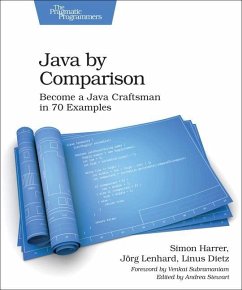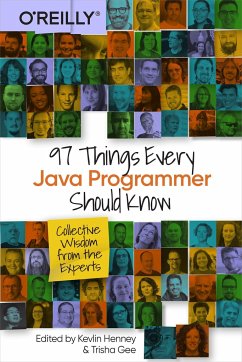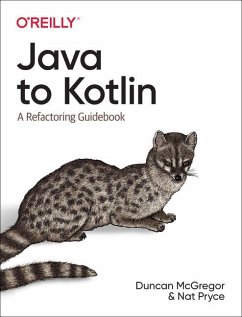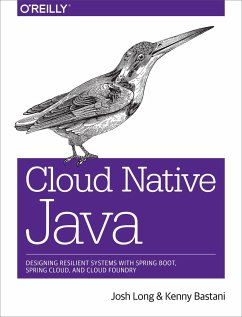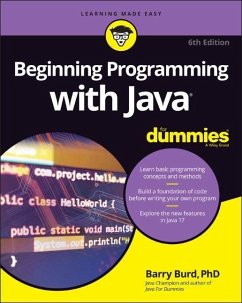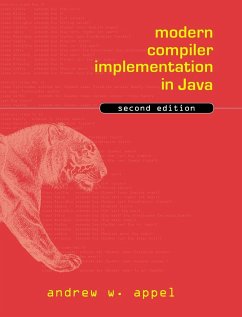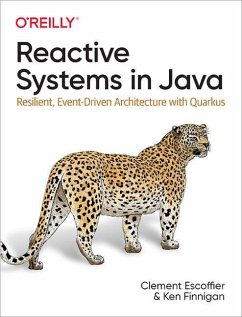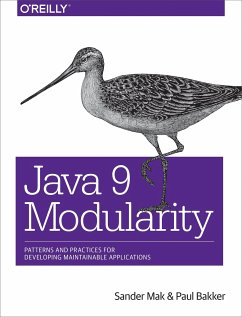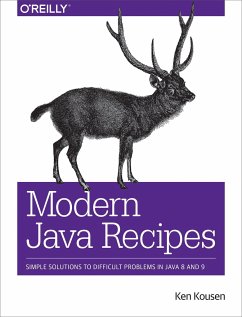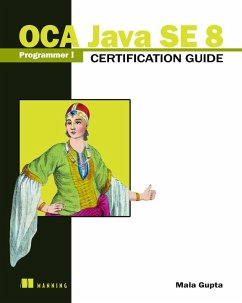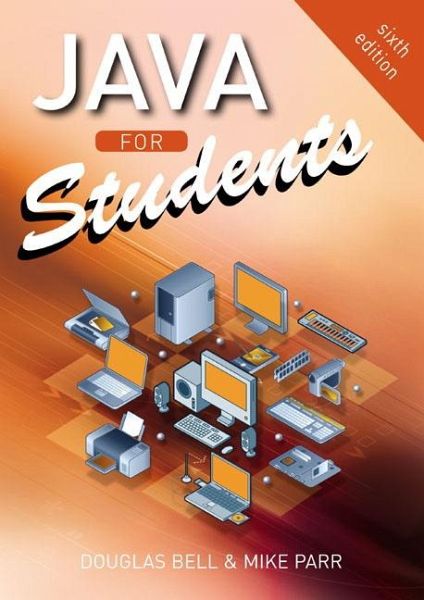
Java For Students

PAYBACK Punkte
63 °P sammeln!
Java for Students
'The best book for my first year programming students'
Gary Hill, Northampton University
' It is really hard to fault it or find a better book'
Ken Chisholm, Edinburgh Napier University
6th edition
If you are new to computer programming then this book is for you! Starting from scratch, it assumes no prior knowledge of programming and is written in a simple, direct style for maximum clarity.
This latest edition of Java for Students has been fully updated to include the new features of Java 6.0. The authors GUI-based approach helps students to build their programming skills by producing exciting and dynamic graphical output.
Key features
· A focus on applications and GUI development with Swing.
· Graphics are used from the start to promote interest and enjoyment and to illustrate programming principles.
· UML 2.0 is used for modelling and design.
· A wealth of exercises and self-test questions with solutions.
Check out the companion website for the book at www.pearsoned.co.uk/bell to find additional resources for both students and instructors.
About the Authors
Douglas Bell and Mike Parr are have many years experience teaching programming in the UK. They have written a number of programming books, including the bestselling Java for Students, Visual Basic for Students and C# for Students. They continue to teach and learn about programming with enthusiasm.
Product Description
This book is for novices
If you have never done any programming before - if you are a complete novice - this book is for you. This book assumes no prior knowledge of programming. It starts from scratch. It is written in a simple, direct style for maximum clarity. It is aimed at first level students at universities and colleges, but it is also suitable for novices studying alone.
The approach of this book
We explain how to use objects early in this book. Our approach is to start with the ideas of variables, assignment and methods, then introduce the use of objects created from library classes. Next we explain how to use control structures for selection and looping. Then comes the treatment of how to write your own classes.
We wanted to make sure that the fun element of programming was paramount, so we use graphics right from the start. We think graphics is fun, interesting and clearly demonstrates all the important principles of programming. But we haven't ignored programs that input and output text - they are also included.
The programs we present use many of the features of a graphical user interfaces (GUIs), such as buttons, scroll bars and text boxes. But we also explain how to write console programs in Java.
We introduce new ideas carefully one-at-a-time, rather than all at once. So, for example, there is a single chapter on writing methods. We introduce simple ideas early and more sophisticated ideas later on.
Features + Benefits
aimed at novices
step-by-step approach uses graphics extensively
uses graphical user interfaces from the outset.
teaches Object-Oriented Programming
uses UML (Unified Modelling Language) as appropriate
uses generics and the enhanced 'for'
introduces objects early
self-test questions with solutions
exercises at the end of each chapter
presents complete programs - not just fragments
Backcover
Java for Students, 6th edition
'The best book for my first year programming students'
Gary Hill, The University of Northampton
'It is really hard to fault it or find a better book'
Ken Chisholm, Edinburgh Napier University
'An excellent rewarding introduction to Java programming
Dr Simon Jones, University of Stirling
If you are new to computer programming then this book is for you! Starting from scratch, it assumes no prior knowledge of programming and is written in a simple, direct style for maximum clarity.
This latest edition of Java for Students has been fully updated to include the new features of Java 6.0. The authors GUI-based approach helps students to build their programming skills by producing exciting and dynamic graphical output.
Key features
· A focus on applications and GUI development with Swing.
· Graphics are used from the start to promote interest and enjoyment and to illustrate programming principles.
· UML 2.0 is used for modelling and design.
· A wealth of exercises and self-test questions with solutions.
Check out the companion website for the book at www.pearsoned.co.uk/bell to find additional resources for both students and instructors.
About the Authors
Douglas Bell and Mike Parr have many years experience teaching programming in the UK. They have written a number of programming books, including the bestselling Java for Students, Visual Basic for Students and C# for Students. They continue to teach and learn about programming with enthusiasm.
Detailed contents
Introduction
Guided tour
The background to Java
First programs
Using graphics methods
Variables and calculations
Methods and parameters
Using objects
Selection
Repetition
Writing classes
Inheritance
Calculations
Array lists
Arrays
Arrays - two dimensional
String manipulation
Exceptions
Files and console applications
Object-oriented design
Program style
Testing
Debugging
Threads
Interfaces
Programming in the large - packages
Polymorphism
Java in context
Appendices :
A. Java libraries
B. The Abstract Window Toolkit
C. Applets
D. Glossary
E. Rules for names
F. Keywords
G. Scope rules (visibility)
H. Bibliography
I. Installing and using Java
Index
'The best book for my first year programming students'
Gary Hill, Northampton University
' It is really hard to fault it or find a better book'
Ken Chisholm, Edinburgh Napier University
6th edition
If you are new to computer programming then this book is for you! Starting from scratch, it assumes no prior knowledge of programming and is written in a simple, direct style for maximum clarity.
This latest edition of Java for Students has been fully updated to include the new features of Java 6.0. The authors GUI-based approach helps students to build their programming skills by producing exciting and dynamic graphical output.
Key features
· A focus on applications and GUI development with Swing.
· Graphics are used from the start to promote interest and enjoyment and to illustrate programming principles.
· UML 2.0 is used for modelling and design.
· A wealth of exercises and self-test questions with solutions.
Check out the companion website for the book at www.pearsoned.co.uk/bell to find additional resources for both students and instructors.
About the Authors
Douglas Bell and Mike Parr are have many years experience teaching programming in the UK. They have written a number of programming books, including the bestselling Java for Students, Visual Basic for Students and C# for Students. They continue to teach and learn about programming with enthusiasm.
Product Description
This book is for novices
If you have never done any programming before - if you are a complete novice - this book is for you. This book assumes no prior knowledge of programming. It starts from scratch. It is written in a simple, direct style for maximum clarity. It is aimed at first level students at universities and colleges, but it is also suitable for novices studying alone.
The approach of this book
We explain how to use objects early in this book. Our approach is to start with the ideas of variables, assignment and methods, then introduce the use of objects created from library classes. Next we explain how to use control structures for selection and looping. Then comes the treatment of how to write your own classes.
We wanted to make sure that the fun element of programming was paramount, so we use graphics right from the start. We think graphics is fun, interesting and clearly demonstrates all the important principles of programming. But we haven't ignored programs that input and output text - they are also included.
The programs we present use many of the features of a graphical user interfaces (GUIs), such as buttons, scroll bars and text boxes. But we also explain how to write console programs in Java.
We introduce new ideas carefully one-at-a-time, rather than all at once. So, for example, there is a single chapter on writing methods. We introduce simple ideas early and more sophisticated ideas later on.
Features + Benefits
aimed at novices
step-by-step approach uses graphics extensively
uses graphical user interfaces from the outset.
teaches Object-Oriented Programming
uses UML (Unified Modelling Language) as appropriate
uses generics and the enhanced 'for'
introduces objects early
self-test questions with solutions
exercises at the end of each chapter
presents complete programs - not just fragments
Backcover
Java for Students, 6th edition
'The best book for my first year programming students'
Gary Hill, The University of Northampton
'It is really hard to fault it or find a better book'
Ken Chisholm, Edinburgh Napier University
'An excellent rewarding introduction to Java programming
Dr Simon Jones, University of Stirling
If you are new to computer programming then this book is for you! Starting from scratch, it assumes no prior knowledge of programming and is written in a simple, direct style for maximum clarity.
This latest edition of Java for Students has been fully updated to include the new features of Java 6.0. The authors GUI-based approach helps students to build their programming skills by producing exciting and dynamic graphical output.
Key features
· A focus on applications and GUI development with Swing.
· Graphics are used from the start to promote interest and enjoyment and to illustrate programming principles.
· UML 2.0 is used for modelling and design.
· A wealth of exercises and self-test questions with solutions.
Check out the companion website for the book at www.pearsoned.co.uk/bell to find additional resources for both students and instructors.
About the Authors
Douglas Bell and Mike Parr have many years experience teaching programming in the UK. They have written a number of programming books, including the bestselling Java for Students, Visual Basic for Students and C# for Students. They continue to teach and learn about programming with enthusiasm.
Detailed contents
Introduction
Guided tour
The background to Java
First programs
Using graphics methods
Variables and calculations
Methods and parameters
Using objects
Selection
Repetition
Writing classes
Inheritance
Calculations
Array lists
Arrays
Arrays - two dimensional
String manipulation
Exceptions
Files and console applications
Object-oriented design
Program style
Testing
Debugging
Threads
Interfaces
Programming in the large - packages
Polymorphism
Java in context
Appendices :
A. Java libraries
B. The Abstract Window Toolkit
C. Applets
D. Glossary
E. Rules for names
F. Keywords
G. Scope rules (visibility)
H. Bibliography
I. Installing and using Java
Index
This book is for novices If you have never done any programming before - if you are a complete novice - this book is for you. This book assumes no prior knowledge of programming. It starts from scratch. It is written in a simple, direct style for maximum clarity. It is aimed at first level students at universities and colleges, but it is also suitable for novices studying alone. The approach of this book We explain how to use objects early in this book. Our approach is to start with the ideas of variables, assignment and methods, then introduce the use of objects created from library classes. Next we explain how to use control structures for selection and looping. Then comes the treatment of how to write your own classes. We wanted to make sure that the fun element of programming was paramount, so we use graphics right from the start. We think graphics is fun, interesting and clearly demonstrates all the important principles of programming. But we haven't ignored programs that input and output text - they are also included. The programs we present use many of the features of a graphical user interfaces (GUIs), such as buttons, scroll bars and text boxes. But we also explain how to write console programs in Java. We introduce new ideas carefully one-at-a-time, rather than all at once. So, for example, there is a single chapter on writing methods. We introduce simple ideas early and more sophisticated ideas later on.
Dieser Artikel kann nur an eine deutsche Lieferadresse ausgeliefert werden.




